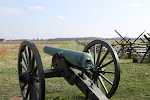Arlington National Cemetery across the Potomac River from Washington,
D.C. performs nearly 30 funeral services each day. Most of burials are military veterans from
World War II, Korea, Vietnam, and the current Middle East conflicts or their
spouses.
March 9 was no different with one exception—one funeral was held to
inter two sailors in what was most likely the last burial of Civil War casualties
at Arlington. The sailors were members
of the crew of the famed Union ironclad USS
Monitor.
Designed by John Ericsson in June 1861, the Monitor was an armored ship with the first-ever rotating turret atop a hull that barely cleared the water. Its high-technology vibrating lever steam engine was groundbreaking technology as well. Ericsson hurried his ship’s completion, assembling it in 118 days at the naval yard in Brooklyn Navy Yard.
Commissioned on February 25, 1862, the Monitor was
assigned to the U.S. Navy support fleet off Hampton Roads, Virginia. The
warship was then towed to Hampton Roads for its fateful encounter with
the CSS Virginia, which had already destroyed two wooden Union Navy
warships with negligible damage to the Confederate ironclad. On March 9, 1862, the
Virginia and Monitor fought
for four hours. Though the
confrontation ended in a draw, the Monitor
prevented the Virginia from gaining
control of Hampton Roads, preserving the Federal blockade of the Norfolk area. Although both ships
served only a matter of months, their brief service proved the viability of
iron vessels and the demise of wooden warships.
Damaged in the battle, the Monitor was
repaired at the Navy Yard in Washington and returned to blockade duty. On her
way back to the Brooklyn Navy Yard later that year, the Monitor sank in rough seas on December 31, 1862, off Cape Hatteras,
North Carolina. Sixteen of her 62 crew were lost.
In August 1973, the wreck’s location was pinpointed. In August 2002, raising the Monitor’s
turret took the cooperation of the U.S. Navy, the Mariner’s Museum in Newport
News, Virginia, and the National Oceanic and Atmospheric Administration.
Inside the turret, divers discovered the remains of two crewmen. The remains of these sailors were removed to the
Joint POW-MIA Accounting Command at Hickam Air Force Base, Hawaii. The U.S.
Navy undertook DNA testing, facial identity reconstruction, and a national
campaign to locate any descendants. Their
identities remained elusive despite DNA comparison to living descendants of
various crew members.
On March 8, the remains of the two
sailors were buried at Arlington National Cemetery with full military honors. It had been 151 years to the day since
the Monitor battled the Virginia to
a standstill at Hampton Roads. At the
funeral service in the Fort Myer Memorial Chapel, author and Civil War
historian James McPherson said, "The sailors on the USS Monitor lived up to the highest traditions of courage and
sacrifice in the United States Navy. To a man, they were all volunteers for
service on this experimental vessel of radical new design."
 |
| U.S. Navy sailors honor the remains of two USS Monitor shipmates at their final resting place at Arlington National Cemetery on March 8. (Photo courtesy of U.S. Navy) |
Describing the ironclad’s final moments at
sea, Secretary of the Navy Ray Mabus quoted from a letter written by William
Keeler, one of the ship’s 46 survivors: "The heavy seas rolled over our
bow, dashing against the pilot house, and, surging aft, would strike the solid
turret with a force that would make it tremble…Words cannot depict the agony of
those moments as our little company gathered on top of the turret…with a mass
of sinking iron beneath us."
While two of the sixteen sailors
who died when the Monitor sank now rest at Arlington, the others
will forever patrol the depths of the Atlantic.
A group marker memorializing all the sailors who perished will be placed
over the unknown’s graves in Section 46 of the cemetery near the Tomb of the
Unknowns amphitheater.
William
Allen, landsman
Norman
Atwater, ensign
William
Bryan, yeoman
Robert
Cook, first cabin boy
William
Egan, landsman
James
Fenwick, seaman
George
Frederickson, acting ensign
Robinson
Hands, third assistant engineer
Robert
Howard, officer’s cook
Thomas
Joice, first class firemen
Samuel
Lewis, third assistant engineer
George
Littlefield, coal heaver
Daniel
Moore, officer’s steward
Jacob
Nicklis, ordinary seaman
Wells
Wentz (aka John Stocking), boatswain’s mate
For the
moment, the graves of the Monitor
unknowns are
| indicated by temporary markers. (Photo by author) |
You can find video of the funeral at www.youtube.com

















No comments:
Post a Comment